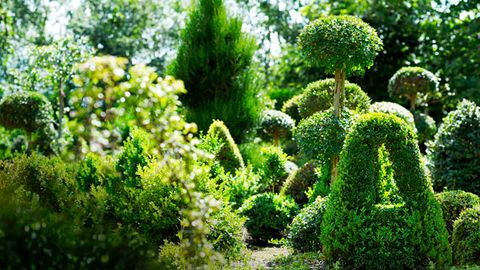Clip art: topiary tips

Topiary master Tim Barbour doesn't simply prune plants, he cuts fine figures out of them, writes Helen Young.
Topiary master Tim Barbour doesn't simply prune plants, he cuts fine figures out of them, writes Helen Young.
"Topiary is an art form," says Tim Barbour, enthusiastically waving a pair of sharp shears around. The owner of Tasmania's largest topiary nursery, and a landscaper himself, Tim has a way with shaping plants that has kept him in business for more than 30 years.
"People either love topiary or hate it," he says. "But I think the reason they hate it is because it's often used in a kitsch way and stuck in the middle of gardens like a gnome. But topiaries are wonderful when they connect with a house and garden in a meaningful way."
Part of Tim's approach is to tailor the species and shape of a topiary to the era of a house. "For instance, for a Georgian house, my topiaries would be simple balls or spirals. I wouldn't use standards with twisted stems or Ficus because they weren't used back then," he says. Size also plays a role in getting it right. "They need to connect in terms of scale. A two-storey building demands larger topiaries or it ends up looking ridiculous."
Tim's interest in topiary began in the early days of his landscaping business, when he had trouble sourcing specimens for the gardens he was designing. "There were only a few box and camellia shapes available. So I started dabbling and experimenting," he says. As his knowledge and expertise increased, so did demand. Now, with more than 2000 square metres of topiary specimens in his nursery, and 40-plus different species in traditional and contemporary shapes, he's the go-to man for topiary in Tasmania.
The nursery is part of a larger open garden that Tim runs with his wife Julie. Called Ericvale it has a restrained scheme, using large groupings of the same plant for impact, including eucalypts, conifers, claret ash, birch, pin oaks, tulip trees and maples. An orchard contains apples, nashi pears, almonds, peaches and persimmons.
In the nursery Tim stocks cones, pyramids, balls, double balls and triple balls, and some unusual free-form shapes, mainly using Dutch and English box, Luma and box honeysuckle. "We also shape peacocks and some rather stylish chooks," says Tim. "They always sell out quickly!"
Each year the topiaries are root pruned by spading around each plant to the depth of the spade. The main lifting time is August to September, when they are dug out and potted up for use or sale.
Tim has tested the types of plants to use for standards, the classic ball-on-a-stick or lollipop shape. He uses camellias, wisteria, hydrangeas, Thuja, Osmanthus, bay and yew. Ivy is also desirable as it's good for shady positions. He creates ivy standards by plaiting the stems around a stake (see below), but cautions these will never be self-supporting. Other popular shapes using ivy are hoops and hearts, which require a technique whereby the plant is trained over a pre-formed wire shape.
Naturally, Tim is a dab hand at pruning. He prunes by eye and encourages everyone to do the same. "Just use your imagination and be creative," he says. He uses a powered hedge trimmer for speed and ease of use, as he has a lot of plants to get through, but recommends home gardeners use high quality hedging shears, with secateurs for detailed work.
Tim Barbour & Associates Landscape Design, Tasmania; (03) 6391 8437.
Recommended topiary species
For balls, cones and pyramidsJapanese box (Buxus microphylla Japonica)
English box (Buxus sempervirens)
Dutch box (Buxus sempervirens ‘Suffruticosa')
Bay (Laurus nobilis)
Yew (Taxus baccata)
White or red cedar (Thuja occidentalis, T. plicata)
Camellia sasanqua and C. japonica
Box honeysuckle (Lonicera nitida)
Lillypillies (Acmena and syzygium)
Chilean myrtle (Luma apiculata)
Orange jessamine (Murraya paniculata)
For metal frames
Ivy of all varieties
Maidenhair creeper (Muehlenbeckia complexa)